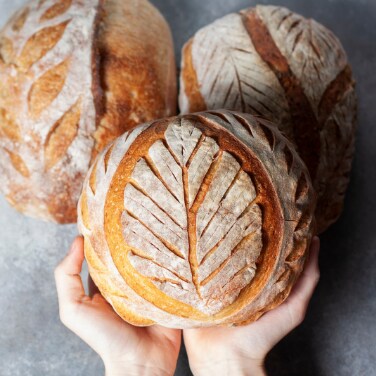Fermentation Fundamentals: The Science of Sourdough Bread
By Sierra McConnell
Breadmaking is one of the more persnickety science experiments you can conduct in the kitchen, but sourdough adds a few extra layers to the process. What better way to engage in a rewarding culinary endeavor than a multi-day process that ends with something delicious to eat?
Why Is This Bread Different from All Other Breads?
What makes sourdough, well, sourdough? Of course, there’s the tang and texture, but the key difference is what makes the bread rise.
In traditionally baked breads, like challah or brioche, yeast is used as a leavening agent, providing lift to the dough as it proofs and bakes. The yeast ferments sugars into carbon dioxide and ethanol. The ethanol evaporates during baking, leaving more subtle flavor compounds than a sourdough starter. The carbon dioxide, however, causes the bread to rise.
In sourdough bread, yeast is still technically part of the recipe, but it comes in the form of a starter—a concoction made of flour and water that’s mixed and fermented for at least a week.
Sourdough Starter Chemistry
A sourdough starter is a thriving community of microorganisms, primarily composed of lactic acid bacteria and wild yeasts. These microbes work together in a symbiotic relationship, each playing a crucial part in fermentation.
To develop a starter, water and flour are combined in equal amounts in a container and covered overnight. The starter must then be “fed” daily, which means discarding a portion of the starter and adding fresh water and flour. Five to 14 days later, the starter will be bubbly, have that distinct sourdough smell, and float when dropped into water.
While there are myriad sourdough recipes online, they all have the same basic instructions: Mix a well-fed sourdough starter with water, salt, and flour. Cover with a towel and leave it in a warm place for about 12 hours or overnight. After the dough has risen, some recipes will call for a “stretch and fold” technique, while others will require traditionally kneading the dough. One of these methods is required to strengthen the gluten in the dough. Next, shape it however you like and let it rise again for another couple of hours. Score with a sharp knife, dust with flour, and bake in a pre-heated Dutch oven. Resist the urge to cut into it right away, though. It needs to rest for a few hours and should only be cut when completely cool. Once it’s ready, dig in!
"Sourdough is more than a culinary staple. It’s a living laboratory with implications that extend far beyond breadmaking."
Is Sourdough Healthier Than Other Bread?
It depends on your definition of “healthier.” Research has shown that the fermentation in the sourdough starter helps prevent sudden increases in blood sugar by lowering the bread’s glycemic index, which slows the absorption of sugar in the bloodstream.
Sourdough is also naturally lower in phytic acid, which is often found in traditionally baked bread and blocks the body from absorbing minerals like zinc and potassium.
Research has even shown that people with a gluten sensitivity can eat sourdough without any of the unpleasant side effects they encounter with other breads.
Innovative Applications in Food Science
Researchers are exploring how they can apply the principles of microbial fermentation in sourdough to other areas of food science, such as:
- Developing new fermented foods with enhanced nutritional profiles
- Creating natural preservatives for food products
- Improving the taste and texture of gluten-free baked goods
- Investigating the potential probiotic effects of sourdough microorganisms on gut health
